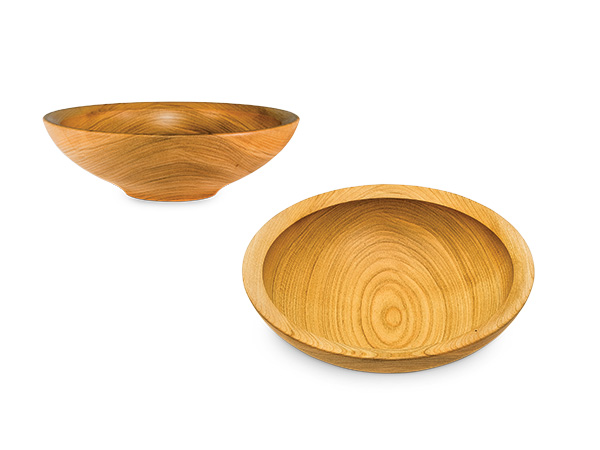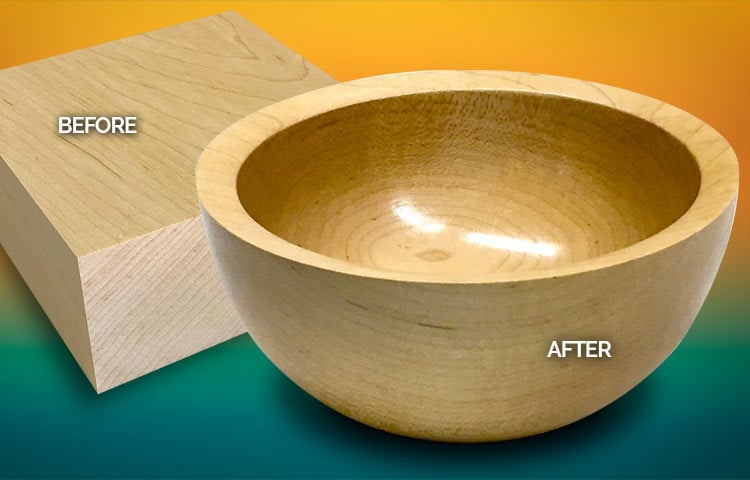Are you curious about what a woodturning bowl is? Well, let me tell you! Picture this: a skilled craftsman using a lathe to transform a block of wood into a beautiful, functional bowl. Cool, right?
Woodturning bowls are unique pieces of art that are both practical and visually appealing. They are created by spinning a block of wood on a lathe while carefully shaping and refining it with specialized tools. The result? A stunning bowl that showcases the natural beauty of the wood.
But why would someone go through all the effort of making a woodturning bowl? Well, it’s not only about the final product. Woodturning is a creative and meditative process that allows artisans to connect with the material and bring out its hidden potential. It’s all about transforming a simple piece of wood into something extraordinary.
So, whether you’re interested in woodworking or simply appreciate the art of craftsmanship, a woodturning bowl is worth exploring. It’s a fascinating blend of skill, creativity, and the beauty of nature, all carved into a functional piece of art. Let’s dive deeper into the world of woodturning bowls and discover the magic behind them.

What is a Woodturning Bowl? Exploring the Art of Woodworking
Woodturning is a form of woodworking that involves creating symmetrical shapes by rotating a piece of wood on a lathe while cutting and shaping it with sharp tools. One of the most popular and versatile items that can be made through woodturning is a bowl. Woodturning bowls are not just functional pieces for holding or serving food; they are also works of art that showcase the natural beauty of wood grains and textures. In this article, we will delve into the world of woodturning bowls, exploring their creation process, different types, and the benefits they bring to both woodworkers and enthusiasts alike.
The Art of Woodturning Bowls: A Step-by-Step Process
Woodturning bowls requires skill and patience, as well as a deep appreciation for the natural characteristics of wood. The process begins by selecting a suitable piece of wood, usually a solid block or a log, that is then mounted onto a lathe. The wood is secured in place between centers or with a faceplate, and the turning begins. The wood is rotated at a high speed, while a sharp tool, such as a gouge or a skew chisel, is used to shape the exterior of the bowl. The woodworker carefully carves away excess material, revealing the desired form. Once the exterior is complete, the woodturner hollows out the center of the bowl using a variety of tools, such as a bowl gouge or a scraper. The depth and shape of the interior can be customized to suit the desired functionality and aesthetic appeal of the bowl. Finally, the bowl is sanded smooth and finished with a protective coating, such as oil or varnish, to enhance the beauty of the wood and protect it from moisture.
The Many Types and Styles of Woodturning Bowls
Woodturning bowls can vary greatly in size, shape, and style, depending on the preferences of the woodworker and the intended use of the bowl. Here are some of the most common types and styles of woodturning bowls:
1. Classic-Style Bowls: These bowls feature a simple and elegant design, with smooth curves and a rounded bottom. They are often used for serving purposes or as decorative pieces.
2. Natural-Edge Bowls: These bowls highlight the natural, irregular edge of the wood, creating a unique and rustic appearance. They are often made from sections of tree branches or logs, allowing the natural contours and bark to remain intact.
3. Segmented Bowls: Segmented bowls are made by combining multiple small pieces of wood into a larger bowl shape. This technique allows for intricate geometric patterns and enhances the visual interest of the bowl.
4. Decorative Pierced Bowls: Piercing is a technique used to create intricate designs and patterns in the walls of the bowl. It adds a touch of elegance and sophistication to the finished piece.
5. Textured Bowls: Texturing techniques, such as carving or burning, can be used to add visual and tactile interest to the surface of the bowl. These bowls often feature patterns or motifs that enhance the natural beauty of the wood grain.
Benefits of Woodturning Bowls: From Beauty to Functionality
Woodturning bowls offers a multitude of benefits, both for woodworkers and those who appreciate the art form. Here are some of the key advantages:
1. Creative Expression: Woodturning bowls allows artisans to express their creativity and showcase their unique style. The process of transforming a raw piece of wood into a functional and visually stunning object is highly satisfying and fulfilling.
2. Sustainability: Woodturning bowls can be an eco-friendly choice, as they can be made from reclaimed or salvaged wood. This reduces the demand for newly harvested timber and helps to minimize waste.
3. Connection with Nature: Working with wood allows woodturners to connect with nature on a deeper level. Each piece of wood has its own story to tell, and the process of revealing its natural beauty through turning enhances the appreciation for the world around us.
4. Functional Art: Woodturning bowls are not just decorative pieces; they are functional objects that can be used to serve and enjoy food. The smooth texture and warmth of wood make them a preferred choice for many food lovers.
5. Handcrafted Quality: Every woodturning bowl is a unique, handcrafted piece that carries the mark of the artisan. The attention to detail and meticulous craftsmanship that goes into creating each bowl result in high-quality products that can be treasured for generations.
6. Therapeutic Value: Woodturning is a meditative and therapeutic practice that allows woodworkers to immerse themselves in the process of creation. It provides a sense of calm and mindfulness, promoting overall well-being and stress relief.
In conclusion, woodturning bowls is a captivating art form that combines skill, craftsmanship, and a deep appreciation for the beauty of wood. From the step-by-step process to the variety of styles and the many benefits it offers, woodturning bowls is a fascinating and rewarding endeavor for both artisans and enthusiasts alike. So, whether you are a woodworker looking to expand your skills or someone who appreciates the art of woodworking, exploring the world of woodturning bowls is sure to inspire and captivate.
Key Takeaways: What is a Woodturning Bowl?
- A woodturning bowl is a type of bowl that is created by using a lathe to shape and carve a piece of wood.
- Woodturning bowls are often made by skilled artisans who use their creativity and expertise to turn a block of wood into a beautiful and functional bowl.
- Woodturning bowls can be made from a variety of different types of wood, including hardwoods like oak or walnut, and softwoods like pine or cedar.
- The process of creating a woodturning bowl involves spinning the piece of wood on a lathe, using various tools to shape and hollow out the bowl, and then sanding and finishing it to create a smooth and polished surface.
- Woodturning bowls can be used for a variety of purposes, including serving food, displaying decorative items, or simply as a beautiful piece of artwork.
Frequently Asked Questions
In this section, we will answer some common questions related to woodturning bowls, a unique form of craftsmanship.
1. How are woodturning bowls made?
Woodturning bowls are crafted on a lathe, a special machine used by woodworkers. To begin, a solid block of wood is carefully mounted on the lathe. As the lathe spins the wood, the craftsman shapes it using specially designed tools. These tools remove excess wood, creating the desired shape and form of the bowl. The craftsman must work with precision and skill to achieve the desired final design.
Once the basic shape is achieved, the bowl is refined by adding details like decorative patterns or textures. After sanding and polishing, the bowl is finished with a protective coating, such as oil or varnish, to enhance its appearance and durability.
2. What types of wood are commonly used for woodturning bowls?
Woodturning bowls can be made from a variety of woods, each with its unique properties and characteristics. Some popular choices include hardwoods like maple, oak, cherry, and walnut. These woods are known for their durability and beautiful grain patterns. Exotic woods such as rosewood, ebony, and padauk are also favored for their striking colors and textures.
The choice of wood depends on several factors, including the desired aesthetic, the intended use of the bowl, and the woodworker’s skill level. It’s essential to select a wood that is not prone to splitting or warping and can withstand frequent use over time.
3. What makes woodturning bowls different from regular bowls?
Woodturning bowls are unique because they are handcrafted from a single piece of wood. Unlike regular bowls made from multiple pieces joined together, woodturning bowls showcase the beauty and natural qualities of a single piece of timber. This method allows the woodworker to create intricate shapes and designs that may not be achievable with other techniques.
The process of woodturning also allows for greater creativity and spontaneity. As the bowl takes shape on the lathe, the woodworker can make adjustments and refine the design in real-time, resulting in a truly one-of-a-kind piece.
4. Can woodturning bowls be used for practical purposes?
Absolutely! While woodturning bowls are often admired for their artistic value, they can also be functional pieces. Many woodturning bowls are designed with practicality in mind, making them suitable for everyday use. These bowls are often finished with food-safe coatings, allowing them to be used for serving food or storing items.
Woodturning bowls can also make beautiful decorative pieces or heirlooms. The combination of artistic craftsmanship and functionality makes woodturning bowls versatile objects that can enhance any home or space.
5. How can I care for and maintain woodturning bowls?
To prolong the life of your woodturning bowls, it’s important to provide proper care and maintenance. Avoid exposing the bowls to direct sunlight or extreme temperature changes, as this can cause the wood to warp or crack. Regularly dust the bowls with a soft cloth, and if needed, clean them with a mild soap and water solution.
Applying a thin coat of mineral oil or specialized wood bowl oil can help preserve the wood’s beauty and protect it from moisture. It’s also recommended to avoid using abrasive scrubbers or harsh cleaning chemicals, as these can damage the wood’s finish. With proper care, your woodturning bowls can last for generations, becoming cherished heirlooms.

Turning Your First Bowl
Summary
Woodturning bowls are handmade bowls made from a single piece of wood on a lathe. The process involves shaping the wood, sanding it smooth, and applying a finish. These bowls can be used for decorative purposes or for serving food. They come in various sizes, shapes, and designs, and can be customized to fit personal preferences. Woodturning bowls require skill and patience, but they result in unique and beautiful pieces of art.
In conclusion, woodturning bowls are special bowls made by hand from wood. They are created on a lathe and undergo a process of shaping, sanding, and finishing. These bowls are versatile and can be used for both decoration and serving. With their individualistic designs, woodturning bowls make for a great addition to any home or as a thoughtful gift for someone special.
